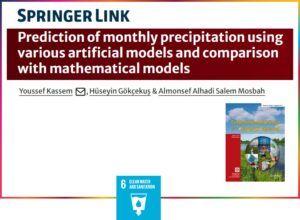
A collaborative effort involving a researchers Kassem and Gökçekuş from Near East University contributes to a study focusing on precipitation prediction in Mediterranean coastal cities along the eastern part of the Mediterranean Sea. The research evaluates the performance of eight empirical models, including mathematical regressions and artificial neural networks, in predicting monthly mean precipitation. By analyzing climate conditions and geographical coordinates as input variables, the study aims to enhance the accuracy of precipitation forecasting.
Two scenarios, differing in input variables, are proposed to assess the models’ performance. Scenario 1 incorporates climate parameters such as temperature, radiation, wind speed, vapor pressure, and evapotranspiration, while Scenario 2 integrates geographical coordinates alongside climate conditions. Monthly data from 2010 to 2021 obtained from TerraClimate are utilized for analysis.
Results indicate that the Poisson regression model (PRM) outperforms other models in predicting monthly precipitation across all selected locations. Additionally, Scenario 2 demonstrates higher prediction accuracy compared to Scenario 1, highlighting the significance of incorporating geographical coordinates in precipitation prediction models.
The study underscores the importance of accurately predicting precipitation for various sectors, including flood management, agriculture, water resource management, and disaster preparedness. By employing advanced modeling techniques and considering both climate conditions and geographical factors, the research provides valuable insights into improving precipitation forecasting accuracy.
Furthermore, the study discusses the effect of combining climate parameters and geographical coordinates on precipitation prediction, offering novel insights into the interaction between climate conditions and geographical features.
The findings suggest that the PRM model, in conjunction with specific combinations of input variables, yields superior prediction accuracy for monthly precipitation. Future research directions may involve investigating the most influential parameters on precipitation prediction to streamline input variables and enhance model efficiency further. Overall, this study contributes to advancing the understanding and prediction capabilities of precipitation in Mediterranean coastal regions, aiding in informed decision-making and resource management strategies.
More Information:
https://link.springer.com/article/10.1007/s11356-022-24912-7#Sec19